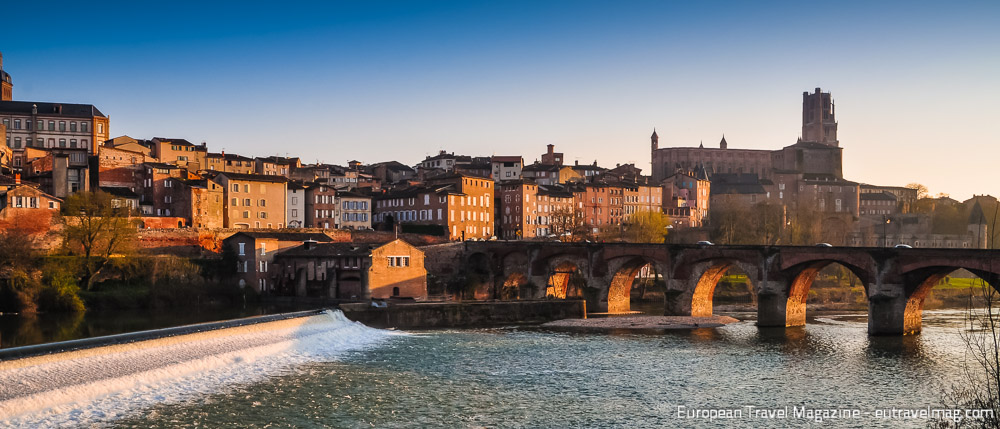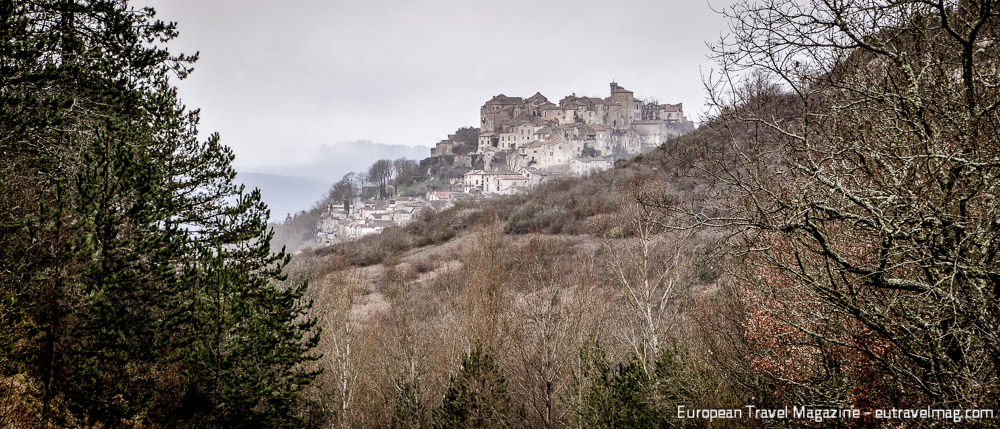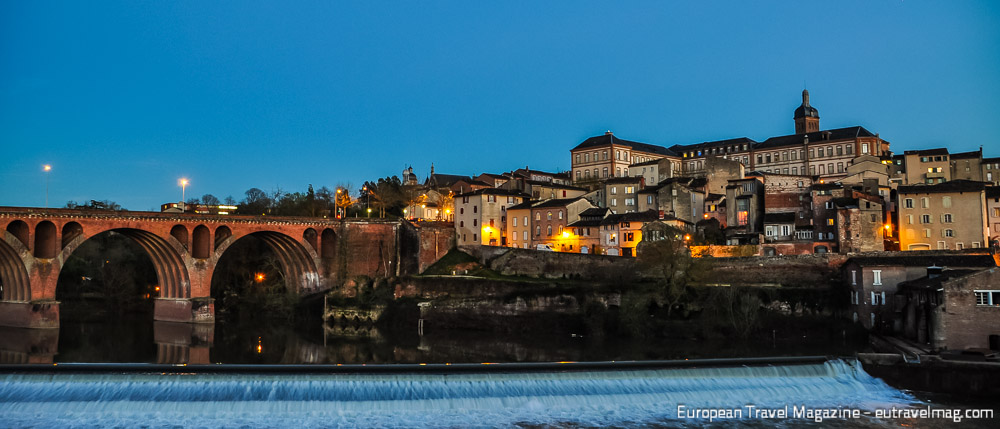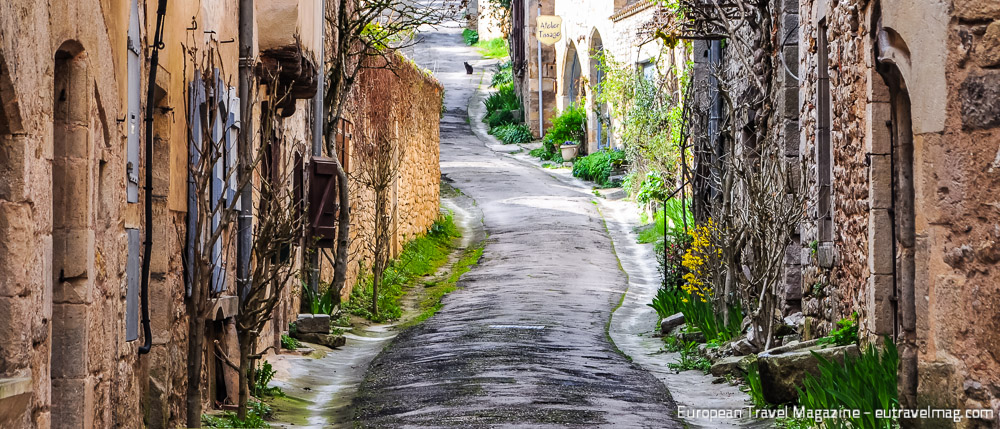Albi rises as a majestic red brick giant over the Tarn river in the Occitanie region of France. It has given name to the horrifying Albigensian Crusade on its own people – the heretic Cathars. It has given birth to great artists and explorers. And it has given rise to the largest brick cathedral in the World.
There are thousands of reasons to visit UNESCO World Heritage awarded Albi and savour an enigmatic French landscape whilst relishing in local produce, wine and cheese. But you don’t have all day, right? Here’s our Top 10 things to see in Albi:
Cathedrale Sainte-Cecile
Whether you’re a church freak or not, you can’t get past Albi’s Cathedral. Not just because it’s the biggest brick cathedral in the world, but because it really defines Albi. It towers majestically over the Tarn river and asserts itself in the landscape.
You can see it from miles away on your drive to Albi, like a dark red beacon guiding you to a safe shore. And you never get lost in Albi, because you can always look to the sky and find the red tower pointing you back to the centre of the city – the Cathedral square Place Sainte-Cécile. No wonder the entire episcopal city was added to the UNESCO list of World Heritage Sites in 2010.
The construction of the Cathedral began in 1282, 58 years after the Albigensian crusade against the Cathars and ended in 1480. And while you can’t get past the huge red brick exterior, the calm, blue coolness of the interior is just as splendid.
Palais de la Berbie
The Palace of Bishops was quite faster to built: only 50 years it took to erect this episcopal palace in the second half of the 13th century by the same man who ordered the construction of the cathedral: Bernard de Castanet.
Today, most of the palace is inhabited by the Toulouse-Lautrec Museum, but what’s (also) exceptional about this brick fortress is the free entrance to the wonderful garden.
Listed as a historical monument, this medieval castle was turned Renaissance palace in the 18th century and the garden is a green jewel amidst all the red brick constructions. Stroll its walls, that rise high above the Tarn river and enjoy the cool breeze from the river and the excellent view to the Pont Vieux and the other side of the water.
Toulouse-Lautrec Museum
And after you’ve enjoyed Palais de la Berbie from the outside, venture inside the museum to witness the most comprehensive collection of works of Henri de Toulouse-Lautrec, which boasts 31 posters, 219 paintings, 563 drawings and 183 lithographs.
Toulouse-Lautrec was born in Albi in 1864 and didn’t live his past 37th birthday. He wasn’t a midget as I used to think, but very small due to fractures t his legs that didn’t heal properly and meant, that he didn’t grow past 1,5 metres. Maybe this handicap and the mockery of people was too much to bear, making him drown his sorrows in alcohol. Toulouse-lautrec didn’t die of any inherited physical disability but of alcoholism.
Fact remains, that he revolutionised commercial art posters, creating provocative, colourful and vivid Art Nouveau paintings in the Belle Èpoque in Paris.
Castelviel and Castelnau
Castelviel is the oldest neighborhood in Albi meaning “old castle”, lies west of the cathedral and used to be isolated from the rest of the city. It is an old fortified village, once part of the castle of the Counts of Toulouse.
After the Albigensian Crusade, the once so powerful Counts fell from grace, because they defended the Cathars. Instead, the area was awarded the Montfort family, as it was Simon de Montfort that lead the crusade.
Narrow streets, half-timbered houses and red brick dominate this area and you feel like you’ve stepped back in time when you stroll the cobblestoned streets. South of the cathedral lies Castelnau, and even though it means “new district” it’s still beautiful medieval half-timbered houses, that adore the crooked streets. If you want to take a peek inside one of the old houses, the Maison du Vieil Alby the best chance to study a medieval village mansion from inside.
Saint-Salvi cloister
The Saint-Salvi cloister is a quiet sanctuary at every time of the day. The sunny green garden and shaded arcade provide either sunshine or shadow – depending on what you’re craving for, and is a lush break from the bricks and stones. It was mutilated during the French Revolution which sold its various wings as national property. Today only the southern wing remains.
From the cloister, you can distinguish the many stages of the construction of the church Saint-Salvi. The fine stone work of the Romanesque, the bricks of the Gothic age, and the symmetrical tower of the Tour Lavit, which was part of the ancient monastery.
Walk under the arcade and exit at Place du Cloître Saint Salvi, where a nice café offers views to the church in a charming setting.
Halle du Marché Couvert
Open every day except monday, from 7 to 14, this market is a great opportunity to get acquainted with the produce of Albi and you can find bakers, cake shops, butchers, delicatessen, groceries, wine, cheese, fish, oysters, greengrocers and even a restaurant.
For those things you can’t find in the market, a supermarket downstairs can provide the rest. And a parking garage further down to make it easy for you to stuff your car full of local delicacies.
Wine
The delicacies of the market are two of our next Top 10 of Albi. Let’s start with the liquid one. Just 20 km west of Albi you have the capital of a wine region with the same name: Gaillac. This 3.300 ha AOC appellation – of which 17% is organic – is one of the most diverse in all of France: they produce red, white, rosé, sparkling, perlé – semi-sparkling, vendanges tardives – sweet wine and primeur – a young wine, like Beaujolais Nouveau.
Not only the diversity is unique, the grape varieties and the terroir of this region are as well. There are several grape varieties, that are unique to the region, like the white Loin de l’Œil, Mauzac and Ondenc grapes as well as the red Duras and Braucol. The Maison des Vins in Gaillac provide great service, sampling and shopping opportunities.
We’ll dive further into this exciting wine region in another article. Stay tuned!
Cheese
There are supposedly 78 different cheeses in the Occitanie, that are unique to the region. Cow, goat or sheep, fresh, mature or downright mouldy – they got it all in Albi.
The market is the best way to discover the different cheeses by sampling your way through the impressive selection. Another option is to head to one of the local farms, that are proud to show you the works and eager to sell their produce.
Lapérouse museum
Jean-François de Galaup, comte de Lapérouse was the French equivalent to James Cook. Explorer, navigator and cartographer, he sailed halfway around the world on a scientific expedition in order to complete maps of the Pacific, establish trade contacts, open new maritime routes and enrich French scientific collections.
The expedition left Brest in 1785 and was last seen March 10 1789 when they left Sydney, Australia in direction of the Solomon Islands. Thankfully, the expedition had dispatched their documentation thus far and their 4-year expedition was not in vain. But they paid the ultimate price.
The small museum is interesting because it shows how difficult it actually was to travel around the world only a little more than 200 years ago. How much of the world was still undiscovered and how much of the planet was still savage. There are short English explanations of the objects on display.
Another reason to visit the museum is the excellent view of the UNESCO World Heritage designated area of Old Albi with panorama of the majestic cathedral, the old bridge, the Berbie palace and the Tarn river, reflecting the beauty of Albi.
Bastide towns
Another great thing about Albi is its surroundings! Historically, it’s a very interesting region and its turbulent history has created its own mark on the landscape.
Everywhere in Europe you can find castles protecting the rich areas of a region. In this region though, the interesting part is not the castles of the nobility, but the villages of the people. The fortified, so-called Bastide towns all over the region were constructed by the descendants of the Cathars and the regular folks, who were contemporary with them. They had all been tyrannized in the past and addressed the underlying feeling of insecurity and mistrust in outsiders by fortifying themselves in villages instead.
If their lords wouldn’t protect them, they certainly would do so themselves.
Today, the Bastides are charming medieval towns and villages well worth a visit. Many of them are rewarded Le Plus Beaux Villages de France, or “The Most Beautiful Villages of France” designation. Often perched on a hilltop they provide stunning views, a cool breeze and artisan shops, that keep the workmanship heritage alive.
Here, heritage and history are not only alive in stones and stories, but in the Occitan people themselves.
General info:
If you want to discover more about the cathars, you might like this article. If you want to know more About France or learn some Useful Information, check out those pieces.
- Episcopal city of Albi
- Albi Tourist Office website (in French)
- Tarn Department Tourism website (in French)
- Occitanie Region Tourism website





































































